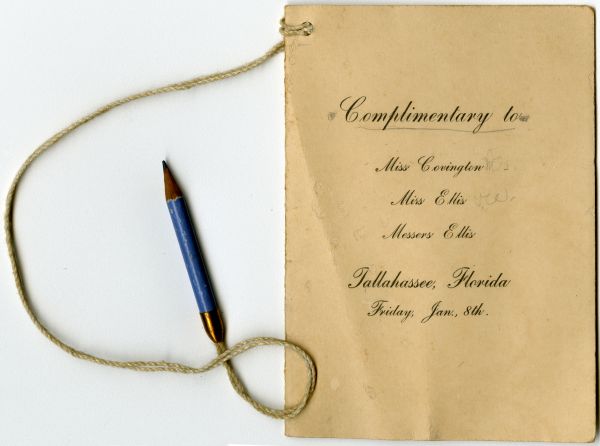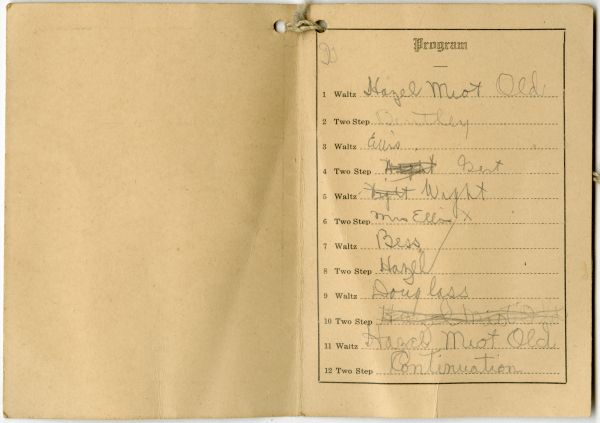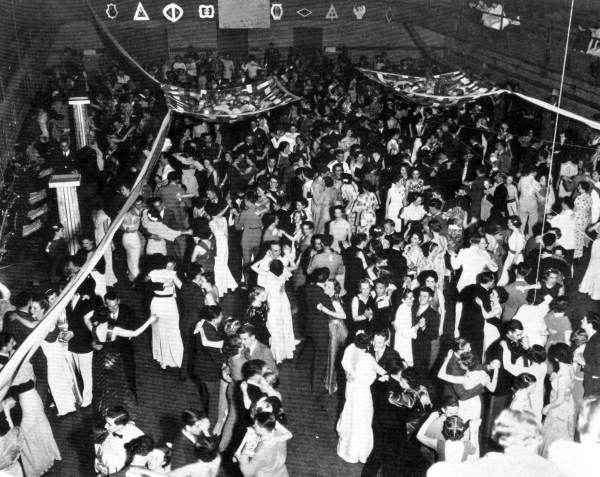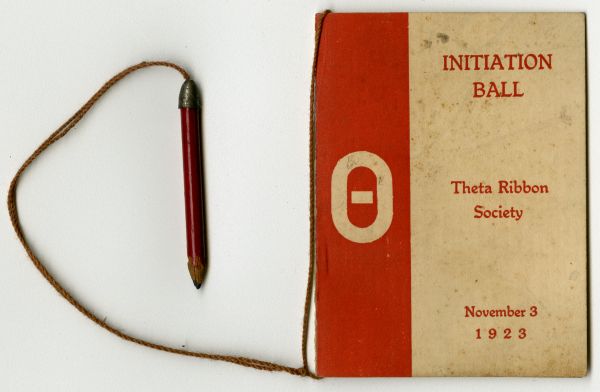Description of previous item
Description of next item
Dance Cards in the Archives
Published September 9, 2018 by Florida Memory
Has someone ever asked you to save some room on your dance card for them, or declined an invitation because their dance card was too full? These days, a person’s “dance card” is almost always a metaphor for their schedule, but in the 19th and early 20th centuries the meaning was much more literal. Formal dances were a popular form of entertainment in those days, and dance cards were an essential part of the etiquette that went along with them.

Dance card for an event given in honor of Miss Covington, Miss Ellis, and Messers Ellis in Tallahassee, 1926, in Box 2, Folder 14, Meginnis Family Papers (Collection N2015-3), State Archives of Florida.
The concept was fairly simple. Women–and in some cases men as well–used dance cards to keep track of who they had promised to dance with throughout the evening. This was necessary for a couple of reasons. First, while today’s sound systems can play for hours on end without complaint, the music at 19th and early 20th century parties came from live musicians who needed a break now and then. As a result, there was usually only a specific number of musical selections planned for dancing. If you really wanted to dance with someone, you had to make sure you were on their schedule!
Dance cards also allowed a party-goer to be strategic in asking for a dance partner. At a formal event, each musical number was designed for a specific kind of dance, and the dancers were expected to not just have good rhythm, but also know the proper dance moves. If you didn’t know how to waltz, for example, you certainly wouldn’t want to sign up to dance a waltz with a partner you were looking to impress. You might sign up for a reel or a two-step instead, if those were your stronger dances. Dance cards helped by including the form of each dance next to its number on the inside of the card.

Inside of a dance card from a dance in Tallahassee in 1926, in Box 2, Folder 14, Meginnis Family Papers (Collection N2015-3), State Archives of Florida.
The cards could be simple, or they could be very ornate, depending on the occasion. A Valentine’s Day dance might feature cards in the shape of a red heart, while dances given in a particular person’s honor might have cards with the person’s monogram. Tiny pencils for filling in the cards were a common feature, usually attached to the cards with a loop of string or ribbon. Sometimes a lady would also use this to attach the card to her wrist.
Dance cards typically came with a few unwritten rules of etiquette, many of which would seem out of step with the times in today’s world. When it came to making dancing engagements, for example, men were supposed to take the lead. Ladies were supposed to wait to be asked. A lady could turn a gentleman’s invitation down, even if the spot was open on her dance card, but if she did it was generally considered impolite for her to accept another man’s proposal to dance that same number. It was also considered improper for a lady to dance every dance at a ball or party.
Dance cards still make an appearance now and then at formal occasions, but for the most part they’ve been relegated to scrapbooks and boxes of memorabilia from years gone by. Here at the State Archives, we often see dance cards included in collections of family papers. They’re a unique kind of source–both a snapshot of a particular occasion and a tool for exploring the social lives of Floridians in a very different era.
Cite This Article
Chicago Manual of Style
(17th Edition)Florida Memory. "Dance Cards in the Archives." Floridiana, 2018. https://www.floridamemory.com/items/show/341935.
MLA
(9th Edition)Florida Memory. "Dance Cards in the Archives." Floridiana, 2018, https://www.floridamemory.com/items/show/341935. Accessed December 17, 2025.
APA
(7th Edition)Florida Memory. (2018, September 9). Dance Cards in the Archives. Floridiana. Retrieved from https://www.floridamemory.com/items/show/341935

 Listen: The Bluegrass & Old-Time Program
Listen: The Bluegrass & Old-Time Program
